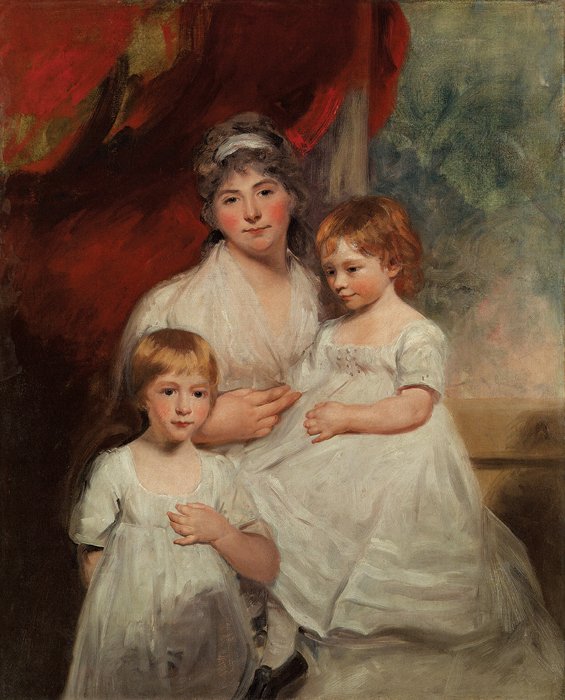John Hoppner, Mrs John Garden and her Children,
c. 1796-1797. Oil on canvas, 127.3 x 101.3 cm.
The Metropolitan Museum of Art, New York.
The French painter Delacroix, who had known Lawrence in London in 1825, wrote an interesting letter to Théophile Silvestre in 1858, in which he gives his judgment of him with the friendliness of youthful reminiscences:
My impressions of that time would be perhaps rather modified in these days; I should perhaps discover in Lawrence an exaggeration in his manner of producing an effect, savouring too much of the Reynolds school; but his excessive delicacy in drawing, the life that he gives to his female studies, which look as if they would speak to you, give him a kind of superiority, as a portrait painter, over Van Dyke himself, whose admirable figures sit so quietly for their portraits. The brilliancy of the eyes, the half-open mouth, are excellently rendered by Lawrence. He gave me a gracious reception; he was pre-eminently a courteous man, except, indeed, when anyone criticised his pictures.
Portrait painting must be considered as the only great style in the English school. I am not speaking only of the most celebrated portraits, for, in a lesser degree, all deserve notice, as, for instance, two that we saw some years ago at Paris. One was a bold, vigorous work of a severe and elevated character, by Jackson; the other, which I greatly preferred, was a picture of a Greenwich pensioner, by Henry Raeburn. It is painted with a wonderfully powerful brush, and treated with a delicacy of rendering and an intelligence which one rarely finds anywhere, especially in English Art. This portrait is inimitable as a type of an English sailor, clean and scrupulous in his appearance, retaining the fair and fresh complexion of the Saxon race, in spite of the red and bronze colouring caused by sun, wind, and intemperance. The glazy eye, fiery nose, mouth with its modestly sensual delights in tobacco and gin, all these are expressed with wonderful meaning. There are very few painters who have been able to manage with such skill the transitions from shade to half-lights, and from half-lights to full-lights. Raeburn, who lived in Edinburgh, far from the bustle of London, has not yet been given the high rank in the estimation of critics which is due to his great talent, I almost said genius.
In spite of breadth and truthfulness, a comprehension in the rendering of life, with its realities and elegancies and national customs and manners, all of which English portrait painters have shown in their pictures, French artists have no cause to be jealous of them, even in admiring their works. At that period, France was able to boast for a whole century of splendid triumphs in the noble art of portrait painting.
That which is known to other schools as high art and historical painting has never had any but the most miserable representatives in England. A few unhappy artists have valiantly attempted to engage in the contest, but they have hopelessly come to grief, and have left only melancholy evidences of their bold endeavours. They are a dismal series of bad imitations, without taste or colour, and with scarcely any composition. The most outrageous and, at one time, the most esteemed of these painters, is Benjamin West[6]. His first historical pictures were: Orestes, The Chastity of Scipio, Agrippina and the Ashes of Germanicus. He painted this last picture for Dr Robert Hay Drummond, Archbishop of York, who presented it to King George III, who quickly accepted West as his favourite painter, an honour which lasted for many years. In 1768, he was made one of the members of the Royal Academy, and, at Reynolds’ death in 1792, he was elected President. For two years prior, he had been Surveyor of Paintings to the King, who gave him an order for a series of large religious pictures. The first of this series is Christ curing the sick in the Temple.
